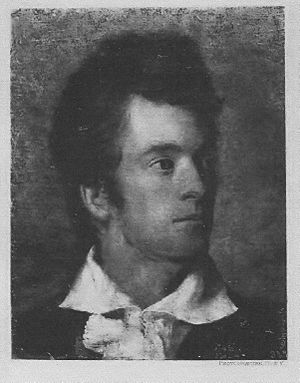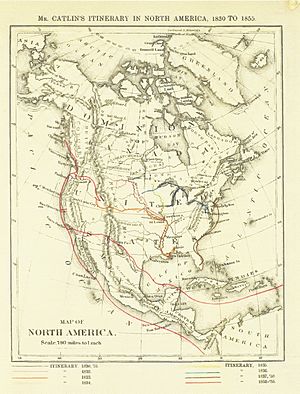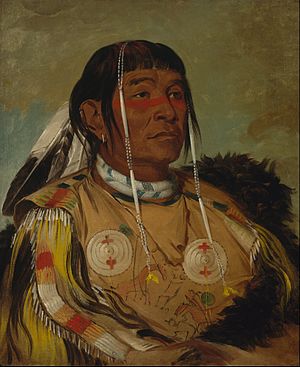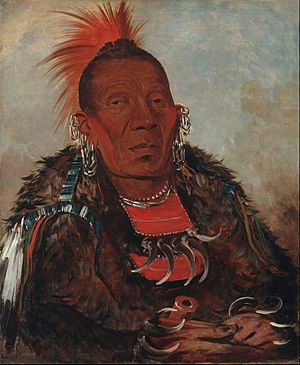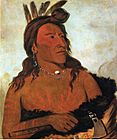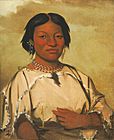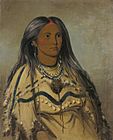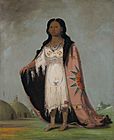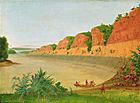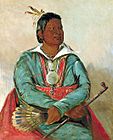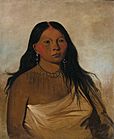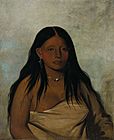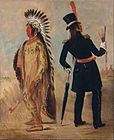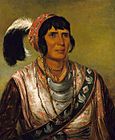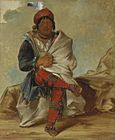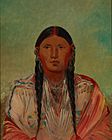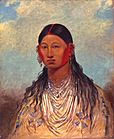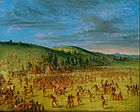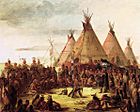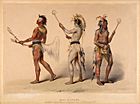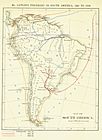George Catlin facts for kids
Quick facts for kids
George Catlin
|
|
|---|---|
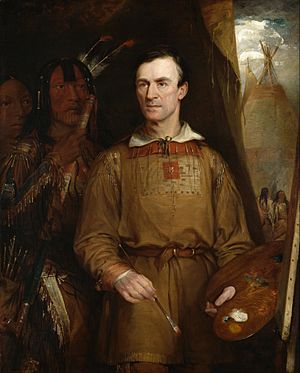
George Catlin by William Fisk, 1849
|
|
| Born | July 26, 1796 Wilkes-Barre, Pennsylvania, United States
|
| Died | December 23, 1872 (aged 76) Jersey City, New Jersey, United States
|
| Alma mater | Litchfield Law School |
| Occupation | Lawyer Painter Author |
| Spouse(s) | Clara Bartlett Gregory |
| Signature | |
George Catlin (born July 26, 1796 – died December 23, 1872) was an American adventurer, lawyer, painter, and writer. He is famous for his many portraits of Native Americans living in the Old West.
During the 1830s, Catlin traveled to the American West five times. He wrote about and painted pictures showing the daily life of the Plains Indians. His early work included drawings of places along the Erie Canal in New York. Some of his drawings were in one of the first books to use a printing method called lithography. This book, published in 1825, showed early images of the City of Buffalo.
Contents
Becoming an Artist and Explorer
George Catlin was born in 1796 in Wilkes-Barre, Luzerne County, Pennsylvania. As he grew up, he met many travelers like trappers, hunters, and explorers. They often stayed with his family while traveling west.
George's father was a lawyer, so George was sent to Litchfield Law School when he was 17. However, he didn't like studying law. He became a lawyer in 1819 but stopped after two years. He decided to travel and study art instead. In 1823, he studied art in Philadelphia and became known for painting portraits. After meeting a group of Native American leaders from the western frontier, Catlin felt a strong desire. He wanted to record the customs and lives of Native American people through his art.
His Journeys West
Catlin started his big adventure in 1830. He went with Governor William Clark on a special trip up the Mississippi River into Native American lands. St. Louis became his main base for five trips he took between 1830 and 1836. He ended up visiting about fifty different tribes.
Two years later, he traveled more than 3,000 kilometers (1,900 miles) up the Missouri River. He reached Fort Union, near where North Dakota and Montana are today. There, he spent several weeks with Native people who had not been much affected by European culture yet. He visited eighteen tribes, including the Pawnee, Omaha, and Ponca in the south. To the north, he met the Mandan, Hidatsa, Cheyenne, Crow, Assiniboine, and Blackfeet. During this time, he created some of his most powerful and detailed portraits.
On later trips along the Arkansas, Red, and Mississippi rivers, and visits to Florida and the Great Lakes, he painted over 500 pictures. He also collected many Native American artifacts.
The Indian Gallery
When Catlin returned east in 1838, he put all his paintings and artifacts together. He called this collection his "Indian Gallery." He started giving public talks, sharing his personal stories about life among the Native Americans. Catlin took his Indian Gallery to big cities like Pittsburgh, Cincinnati, and New York. He displayed his paintings close together, covering the walls. Visitors could find out about each painting using a number from his catalog.
Soon after, he began trying to sell his collection to the U.S. government. He wanted his life's work to be kept safe and together. However, his touring gallery didn't make enough money, and the United States Congress first said no to buying his works.
In 1839, Catlin took his collection to Europe. He toured major cities like London, Brussels, and Paris. At first, he attracted large crowds to his Indian Gallery. A French art critic named Charles Baudelaire admired Catlin's paintings. He said Catlin "brought back alive the proud and free characters of these chiefs, both their nobility and manliness."
Catlin kept trying to convince officials in Washington, D.C., to buy his collection. But his efforts failed. In 1852, he had to sell his original Indian Gallery, which by then had 607 paintings, because he was in debt. A businessman named Joseph Harrison bought the paintings and artifacts. He stored them in a factory in Philadelphia.
Catlin spent the last 20 years of his life trying to paint his collection again. He recreated more than 400 paintings. This second collection is known as the "Cartoon Collection." These works were based on the outlines he had drawn from his original paintings.
In 1841, Catlin published a two-volume book called Manners, Customs, and Condition of the North American Indians. It had about 300 engravings. Later, he published more works about his travels and observations.
From 1852 to 1857, he traveled through South and Central America. He also explored more of the American West. His experiences from these later years are in books like Last Rambles amongst the Indians of the Rocky Mountains and the Andes (1868).
In 1872, Catlin went to Washington, D.C., invited by Joseph Henry. Henry was the first secretary of the Smithsonian. Catlin worked in a studio at the Smithsonian "Castle" until he died later that year in Jersey City, New Jersey. In 1879, Harrison's widow gave the original Indian Gallery, with over 500 works and related items, to the Smithsonian.
Today, most of Catlin's first Indian Gallery, painted in the 1830s, is at the Smithsonian American Art Museum. Many of his sketches are at the American Museum of Natural History in New York City. The Huntington Library in California also has many of his illustrations.
Some of Catlin's claims have been questioned. For example, he said he was the first white man to see the Minnesota pipestone quarries. The stone found there was even named catlinite after him. However, other white visitors had been there before him, and the Lewis and Clark noted the quarry in their journals in 1805.
Later Artworks
One of Catlin's most unusual later paintings is "Le Chat d'Ostende," painted in 1868. It shows a playful cat. People have said it has the same wonder and excitement as his paintings of Native Americans.
After the U.S. Congress didn't buy his Indian Gallery in 1838, Catlin moved his family to England in 1839. He then went to Paris in 1845 and later lived in Ostend. In 1871, after more than 30 years away, Catlin returned to the United States. He likely brought the cat painting with him. This painting shows a quiet, homey scene, very different from the wild American bison he often painted. The cat itself, with its long fur, looks a bit like a bison. Its human-like face might even be a self-portrait, playing on his last name.
Observations on Breathing Habits
Catlin is also remembered for his research on mouth breathing. This interest came from what he saw during his travels. He wrote a non-fiction book in 1862 called The Breath of Life. It was later renamed Shut Your Mouth and Save Your Life.
In his book, he shared his experiences from the West. He noticed that all the Native American communities he met had a common habit: they preferred to breathe through their nose, not their mouth. He also observed that they had perfectly straight teeth. He often heard that they believed mouth breathing made a person weak and sick. They thought nasal breathing made the body strong and healthy. He also saw mothers gently close their infants' mouths while they slept. This was to teach them to breathe through their nose. Catlin wrote his book to share these observations. He believed that everyone could improve their health by keeping their mouth shut.
Family and Passing
George Catlin met Clara Bartlett Gregory in 1828 in Albany, New York. They got married, and she joined him on one of his trips west. They had four children. Sadly, Clara and their youngest son died in Paris in 1845.
George Catlin passed away on December 23, 1872, at the age of 76. He died in Jersey City, Hudson County, New Jersey.
Honors
- He was inducted into the National Rivers Hall of Fame in 2001.
In Books and TV
George Catlin and his work appear in the 2010 novel Shadow Tag by Louise Erdrich. In the book, a character named Irene America writes her unfinished college paper about him. One of his paintings from 1834, Comanche Feats of Martial Horsemanship, was shown in the TV series Watchmen.
Gallery
-
Mó-sho-la-túb-bee, He Who Puts Out and Kills, Chief of the Choctaw Tribe, 1834
-
Wi-jún-jon, Pigeon's Egg Head (The Light), Going To and Returning From Washington, 1837–1839
-
Os-ce-o-lá, The Black Drink, a Warrior of Great Distinction, 1838
-
Attacking the Grizzly Bear, 1844
-
Tipis, c. 1850
-
Ball players, hand-colored lithograph, unknown date
-
Portrait of Chief Comcomly, unknown date
Works by Catlin
- Catlin, George (1841). Letters and Notes on the Manners, Customs and Conditions of North American Indians. This two-volume book describes his travels and observations.
- Catlin, George (1862). The Breath of Life (later called Shut Your Mouth and Save Your Life). This book shares his ideas about breathing.
See also
 In Spanish: George Catlin para niños
In Spanish: George Catlin para niños
- Catlin Hall, Wilkes College
- Chief Mahaska
- Mato-tope
- Mouth breathing
- Benjamin O'Fallon, a friend and collector of Catlin's art


